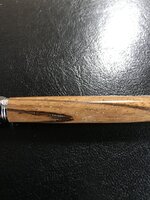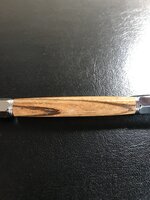Today I made my first attempts both at turning diagonally cut (unstabilized) zebrawood and applying a CA finish.
To my surprise, though certainly not perfect, the CA part didn't go horribly. The zebrawood on the other hand - even with sharp tools and turning cautiously, the wood still ended up with "pits" in it. I'm sure that's not the right terminology, but basically lots of small areas that are lower than the rest of the wood. At some point during sanding, these must have collected some white dust that eventually got sealed in by the CA.
Is there a trick to turning and finishing this wood (and similar types) to get a more even surface? Any tips and would be much appreciated!
To my surprise, though certainly not perfect, the CA part didn't go horribly. The zebrawood on the other hand - even with sharp tools and turning cautiously, the wood still ended up with "pits" in it. I'm sure that's not the right terminology, but basically lots of small areas that are lower than the rest of the wood. At some point during sanding, these must have collected some white dust that eventually got sealed in by the CA.
Is there a trick to turning and finishing this wood (and similar types) to get a more even surface? Any tips and would be much appreciated!


